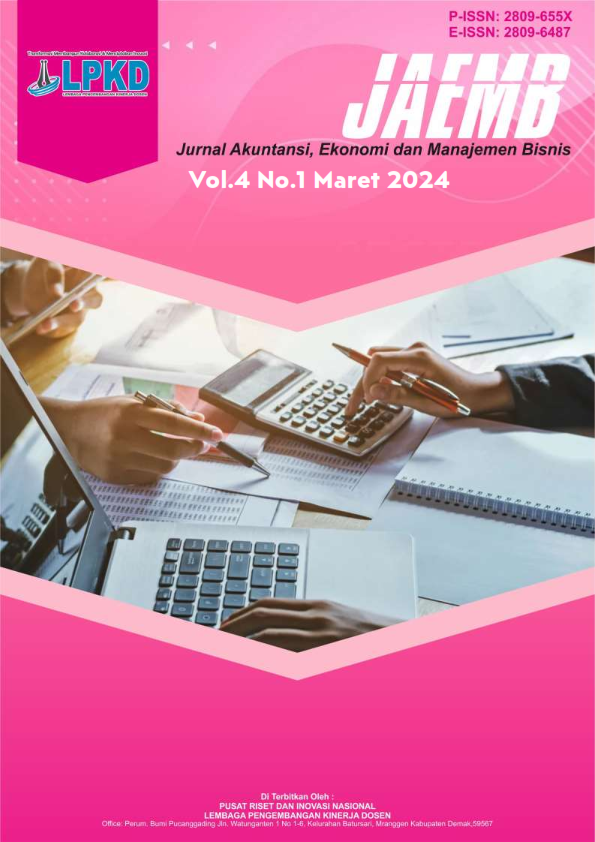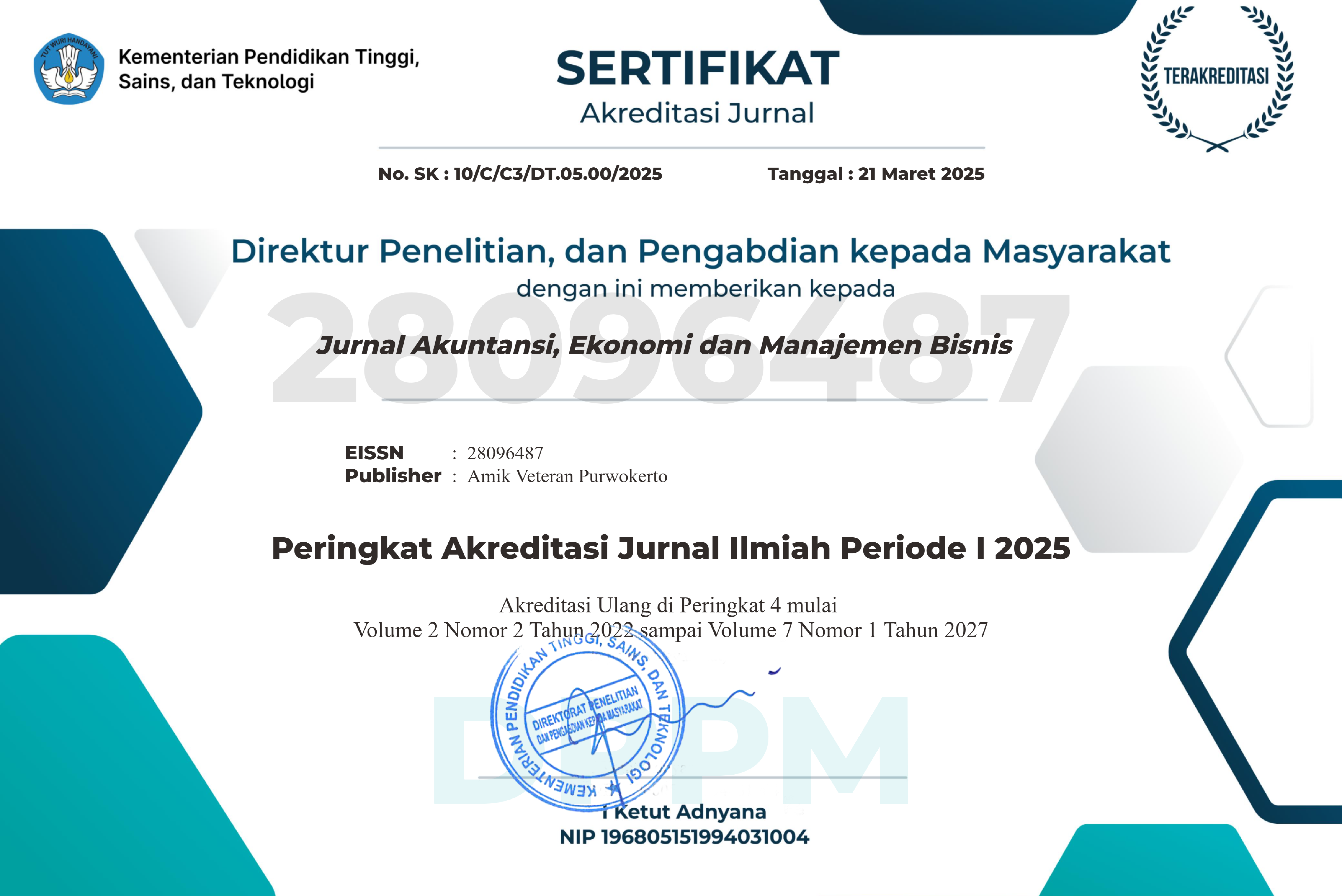Deteksi Financial Statement Fraud dengan Fraud Diamond
DOI:
https://doi.org/10.55606/jaemb.v5i1.5751Keywords:
Fraud Diamond, manipulasi laporan keuangan, target finansial, peluang, kapabilitas, rasionalisasi, tekanan eksternal, sektor finansialAbstract
This research is motivated by concerns about the increasing cases of manipulation of financial statements that have the potential to undermine investor confidence and disrupt the stability of the financial sector. In this case, the Fraud Diamond approach which includes four elements, namely foresight, opportunity, rationalization, and capability is used as a basis to identify indications of fraud in financial reporting. This study uses a quantitative approach with the object of research as many as 68 companies from the financial sector selected through purposive sampling techniques. The collected data was analyzed using multiple linear regression methods. The results of the analysis show that financial target and opportunity indicators have a significant influence in detecting the possibility of manipulation of financial statements. Meanwhile, financial stability, external pressures, rationalization, and individual abilities did not show a significant influence on fraud detection.
References
[1] Diansari, R. E., & Wijaya, A. T. (2019). Diamond fraud analysis in detecting financial statement fraud. Jurnal Akuntansi, 8(2), 112–120.
[2] ACFE Indonesia. (2019). Survei Fraud Indonesia. Jakarta: ACFE Indonesia Chapter.
[3] Kultsum, S. U., & Triyatno, D. N. (2022). Pengaruh fraud diamond terhadap financial statement fraud (Studi terhadap perusahaan anggota indeks Sri-Kehati yang terdaftar di Bursa Efek Indonesia tahun 2016-2020). Jurnal Ilmiah Ekonomi dan Bisnis, 10(2), 1195–1206.
[4] Almujaddedi, M. S., & Hayati, R. (2022). Determinan indikator fraud diamond terhadap internal control dan kecurangan laporan keuangan. Jurnal Ilmiah Akuntansi dan Keuangan, 6(1), 45–54.
[5] Umar, H., Partahi, D., & Purba, R. B. (2020). Fraud diamond analysis in detecting fraudulent financial report. International Journal of Scientific and Technology Research, 9(3), 6638–6646.
[6] Yesiariani, M., & Rahayu, I. (2017). Deteksi financial statement fraud: Pengujian dengan fraud diamond model. Jurnal Akuntansi dan Investasi, 18(2), 117–128.
[7] Handayani, R., Sutarjo, A., & Yani, M. (2021). Pengaruh pressure, opportunity dan rationalization (fraud triangle) terhadap financial statement fraud (Studi empiris pada perusahaan manufaktur yang terdaftar di Bursa Efek Indonesia Tahun 2013–2017). Pareso Jurnal, 3(3), 683–694.
[8] Pribadi, A., & Nuryatno, M. (2019). Pengaruh pressure, opportunity, rationalization dan capability terhadap financial statement fraud. Inovasi, 15(2), 120–127.
[9] Puspitha, M. Y., & Yasa, G. W. (2018). Fraud pentagon analysis in detecting fraudulent financial reporting (Study on Indonesian Capital Market). International Journal of Sciences: Basic and Applied Research, 42(5), 93–109.
[10] Al-Farizi, Z. (2020). Fraud diamond terhadap financial statement fraud. Balance: Jurnal Akuntansi dan Bisnis, 5(1), 71–82.
[11] Akhmadi, A., Nurohman, N., & Robiyanto, R. (2021). The mediating role of debt and dividend policy on the effect of profitability toward stock price. Jurnal Manajemen dan Kewirausahaan, 22(1), 1–10.
[12] Moratis, L. (2018). Signalling responsibility? Applying signalling theory to the ISO 26000 standard for social responsibility. Sustainability, 10(11), 1–20.
[13] Kismawadi, E. R., Al Muddatstsir, U. D., & Hamid, A. (2020). Fraud pada lembaga keuangan dan lembaga non keuangan. Depok: RajaGrafindo Persada.
[14] Syahria, R. (2019). Detecting financial statement fraud using fraud diamond (A Study on banking companies listed on the Indonesia Stock Exchange period 2012–2016). Asia Pacific Fraud Journal, 4(2), 183–190.
[15] Hikmah, A. R. (2021). Akuntansi & manajemen sektor publik. Surabaya: Global Aksara Press.
[16] Sudarno, Renaldo, N., Hutahuruk, M., & Junaedi, A. T. (2022). Teori penelitian keuangan. Malang: CV Literasi Nusantara Abadi.
[17] Simatupang, S., Candra, V., Julyanthry, Rambe, M. T., & Sinta, I. (2022). Studi kelayakan bisnis. Jakarta: Prenada Media.
[18] Setiawan, T., Breliastiti, R., Riswandari, E., & Olivia, T. (2022). Perancangan sistem pengendalian manajemen dalam perusahaan. Yogyakarta: Jejak Pustaka.
[19] Hantono. (2018). Konsep analisa laporan keuangan dengan pendekatan rasio dan SPSS. Yogyakarta: Penerbit Deepublish.
[20] Purba, R., & Umar, H. (2021). Kualitas audit & deteksi korupsi. Medan: Merdeka Kreasi.
[21] Thian, A. (2021). Dasar-dasar auditing: Integrated and comprehensive edition. Yogyakarta: Penerbit Andi.
[22] Luwihono, A., & Palpialy, J. (2021). Buku ajar instrumentasi dan pengukuran. Yayasan Kita Menulis.
[23] Zulzilawati, Z., & Wahyuni, N. (2021). Beneish ratio index sebagai alat deteksi kecurangan laporan keuangan pada perusahaan manufaktur. El Muhasaba: Jurnal Akuntansi, 12(2), 181–193.
[24] Yasar, B., Martin, T., & Kiessling, T. (2020). An empirical test of signalling theory. Management Research Review, 43(11), 1309–1335.
[25] Elisa, M., & Guido, P. (2018). Forward-looking information in integrated reporting: A theoretical framework. African Journal of Business Management, 12(18), 555–567.
[26] Sari, T. P., & Lestari, D. I. T. (2020). Analisis faktor risiko yang mempengaruhi financial statement fraud. Jurnal Ilmiah Akuntansi dan Keuangan, 5(2), 89–98.
[27] E. Hendrawati, M. Pramudianti, and K. Abidin, "Fraud prevention of village fund management," International Journal of Islamic Business and Management Review, vol. 2, no. 1, pp. 76–87, 2022.
Downloads
Published
How to Cite
Issue
Section
License
Copyright (c) 2025 Jurnal Akuntansi, Ekonomi dan Manajemen Bisnis

This work is licensed under a Creative Commons Attribution-ShareAlike 4.0 International License.








